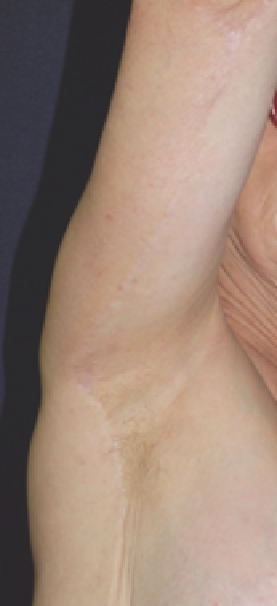Biomedical Engineering Reference
In-Depth Information
The use of 1550-nm fractional resurfacing laser out-
performed the use of the 595-nm PDL in a randomized split-
scar study conducted by Tierney and colleagues (73). Fifteen
scars of minimum 2 months after Mohs' surgery received four
treatments at 2-week intervals and were evaluated regarding
dyspigmentation, thickness, texture, and overall cosmetic
appearance. Fluences of 70 mJ at treatment level 8 (coverage
23%) were used for the Fraxel SR 1500, whereas fl uences of
7.5 J/cm
2
with a pulse duration of 0.45 ms were used for the
PDL. The Fraxel Re:Store was superior in all categories of eval-
uation with a mean cosmetic improvement of 75.9% versus
53.9% of improvement on the PDL-treated half of the scar. In
addition, the 1550-nm fractional resurfacing showed unique
improvement in hypopigmented scars (65% vs. 0%) and atro-
phic scars (68% vs. 13%). The authors attribute the success of
Fraxel® Re:Store to both hypertrophic and atrophic scars to
the controlled delivery of high fl uences to the deep dermis,
which serves to maximize the tissue effects of normalization of
neocollagenesis and collagenolysis. In addition, scars with sig-
nifi cant erythematous component showed signifi cant improve-
ment with the nonablative fractional laser likely due to specifi c
targeting of dermal blood vessels, which has been demon-
strated histologically (Fig. 9.1) (59).
Repigmentation of hypopigmented scars with NAFR has
been reported by previous studies in the literature (74,75).
Mechanisms of partial repigmentation remain speculative
but may be attributed to stimulation of melanocyte prolifera-
tion and migration from the periphery of the wound (76,77).
The excimer laser has been effective in the repigmentation of
hypopigmented scars; however, the results diminished over time
and maintenance was required at 1-4 months (78). In 2007,
Glaich and colleagues conducted a pilot study with seven
patients with hypopigmented facial scars (six from infl amma-
tory acne and one from a gas fi re) treated with a series of two
to four Fraxel Re:Store treatments at 4-week intervals (74).
Energy settings ranged from 7 to 20 mJ at a total density of
1000-2500 MTZ/cm
2
(35-87.5% total coverage). At 4 weeks
after the last treatment, independent physician evaluation
revealed 51-75% improvement in hypopigmentation in six of
seven patients. All patients reported improvement in hypopig-
mentation lasting greater than 3 months after last treatment.
Massaki and colleagues combined the use of erbium-doped
1550-nm fractionated laser (Fraxel Re:Store) with topical
bimatoprost and either topical tretinoin or pimecrolimus for
the treatment of hypopigmented scars (79). Fourteen patients
with hypopigmented scars from various causes were treated
with an average of 4.5 sessions of Fraxel Re:Store at 4- to 8-week
intervals and simultaneously started topical bimatoprost and
tretinoin or pimecrolimus. At 4 weeks after the last laser treat-
ment, 5 patients had more than 75% improvement in hypo-
pigmentation and 12 had more than 50% improvement.
Noteworthy is that after a mean follow-up of 20.1 months, all
patients showed persistent clinical improvement. Although
additional studies are required to compare the effi cacies of
these treatment modalities individually, this combination ther-
apy appears to have a synergistic effect in the improvement of
hypopigmented scars (Fig. 9.2).
Pham and colleagues investigated the effi cacy of 1550-nm
Fraxel in 13 patients with mostly atrophic and hypopigmented
facial surgical scars (80). Four treatments were performed at
intervals of 4 weeks at an initial setting of 40 mJ and treatment
level 4 (11% density). Patients' assessments showed statistically
(
A
)
(
B
)
Figure 9.1
(
A
) Erythematous atrophic scar 6 months after brachioplasty. (
B
) Signifi cant improvement is seen in the scar 6 months following four treatments with
Fraxel Re:Store at monthly intervals using 20 mJ and 20% density.


















